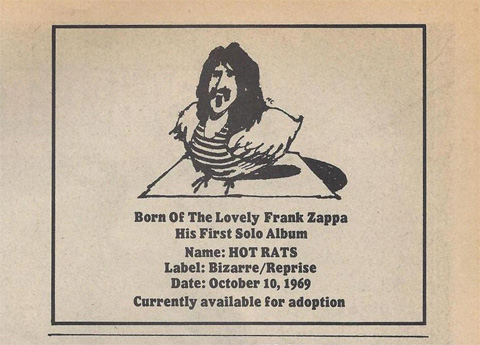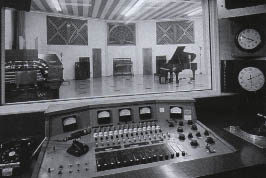The Cover Art
Original album credits
COVER DESIGN: CAL SCHENKEL □ INTERIOR DESIGN: JOHN WILLIAMS
Cal Schenkel, interviewed by Lewis Saul, February 3, 1999
See, after I did the artwork for Uncle Meat, I quit. I said, fuck, I'm leaving. I'm not getting enough money—I had complained and complained for a long time. I was doing all this—they wanted me to do Alice Cooper, GTO's, all this other stuff—I said, I'm not doing this for a hundred bucks a week!
[...] I quit then I went back east for a while—I came back to California, and I saw Frank and he said, "oh, I want you to do some work," but after that I was freelance, I was no longer an employee.
[...] I laid out the front cover [of Hot Rats], then I quit. [Andee Cohen Nathanson] went and shot the photos—I mean, that's really all I did is I just put together some press type deals for the cover, and then I split, and then John Williams put the rest of the package together—John Williams did all of this . . . [...] These are my photos. These are photos I took in London and in Europe. And I'll tell you what's what in a minute, but, these photos I took—these are somebody else's photos—and John Williams did all the inside design while I was gone, and then he also did Burnt Weeny Sandwich, utilizing artwork that I had done earlier, you see?
mid 69 Cover photos by [Andee Cohen Nathanson] of Miss Christine in an abandoned BeverlyHills lilypond. Inside photos by CS (Euro-from first tour):
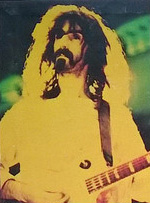
Top #1—FZ on stage, (probably) Amsterdam;
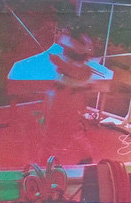

2,3-Apostolic Studios (or Mayfair, I'm not sure which) ("Frog Hollow" T-Shirt courtesy Richard Isgrigg's brother), NY;

4—on the ferry to Goteborg, Sweden;
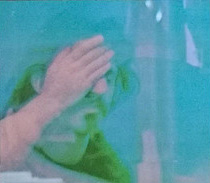
5—FZ at home.
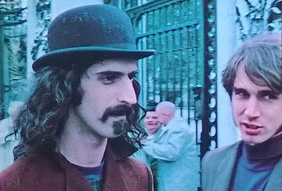
Bottom left—FZ & Ian at Buckingham Palace;
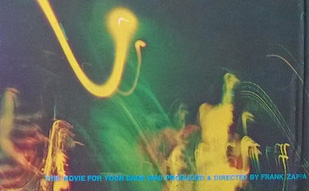
the live shot next to it is from (probably) Amsterdam;
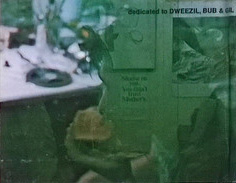
bottom #3 at FZ's Charles St. apt. in NY.

The Beefheart photo, as well as the photos on Trout Mask (except cover) from the Magic Band residence/studio in Woodland Hills, 1968/9 -by Ed Caraeff.

Large FZ photo by Bruce Linton.
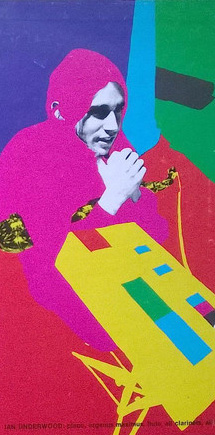
CS Ian Euro-photo, posterized by John Williams, who also co-designed this album package.
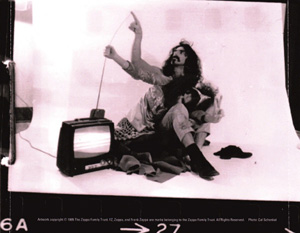
95RR-inlay: photo by CS of FZ & Miss Christine from a session at the Log Cabin, summer 68.
Note: In my post [...] I erroneously referred to Ed Caraeff as the photographer of the Hot Rats cover photos. The Hot Rats cover photos are by Andee Cohen Nathanson.
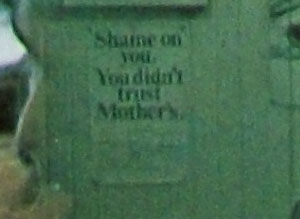
IT: There's that little picture on the Hot Rats cover saying "Shame on you, you didn't trust the Mothers." Now what was that about the audience?
Z: That was from an ad. It didn't say THE Mothers. It said, "Shame on you. You didn't trust Mother's," and it was an ad for Mother's Gefilte Fish and it was based on the fact that some people had died of botulism from this particular product and they were advertising that they'd cleaned up their material.
The Musicians
Original album credits
FRANK ZAPPA: guitar, octave bass, percussion
IAN UNDERWOOD: piano, organus maximus, flute, all clarinets, all saxes.
MUSICIANS: CAPTAIN BEEFHEART—vocal on "Willie The Pimp" (courtesy Straight Records) □ SUGAR CANE HARRIS—violin on "Willie The Pimp" & "The Gumbo Variations" □ JEAN LUC PONTY—violin on "It Must Be A Camel" (courtesy World Pacific Records) □ JOHN GUERIN—drums on "Willie The Pimp," "Little Umbrellas" & "It Must Be A Camel" □ PAUL HUMPHREY—drums on "Son Of Mr. Green Genes" & "The Gumbo Variations" □ RON SELICO—drums on "Peaches En Regalia" □ MAX BENNETT—bass on "Willie The Pimp," "Son Of Mr. Green Genes," "Little Umbrellas," "The Gumbo Variations" & "It Must Be A Camel" □ SHUGGY OTIS—bass on "Peaches En Regalia"
Octave Bass
What is an "octave bass"?
It's a bass that's been speeded up an octave to put it up into guitar range. Speeding it up not only changes the rate that you play the notes, but it changes the envelope of the notes and gives a punchier attack. And you know how a bass will ring for a long time? It gives you a different kind of sustain; the sustain comes out an octave higher.
Johnny Otis
[FZ] had also made contact with Johnny Otis, the hero of his youth, who was now working for the Musician's Union. [FZ] blockbooked the last two weeks of July at TT&G studios and hired Johnny Otis as bandleader.
Don Sugarcane Harris
FZ, quoted in the liner notes of The Lost Episodes (1996)
To me, he was a legend. I had records he made in high school. "Soul Motion," a favorite of mine, had a mean-ass blues violin solo. While making the Hot Rats LP, I thought, "Wouldn't it be great if I could find that guy and put him on the album?" Since Johnny Otis was a DJ from that period in music, I called him. He found Harris in jail—he was in on a drug bust—and we bailed him out. Johnny Otis said he was a very important musician who was needed for recording work.
Max Bennett
Max Bennett, interviewed by Alessandro Pizzin, c. 2007
I received a telephone call one late afternoon from John Guerin (drummer on the Hot Rats album) asking me if I could record that nite. Since I was not working, I accepted the job at 7pm and that's when we started recording the Hot Rats album.
We spent a few evenings on the Hot Rats project and recorded other material which turned out to be Chunga's Revenge and music for various other projects. Some of the other projects I was not aware of until later, so I don't remember the circumstances of each one. [...] Please keep in mind that I was extremely busy during this time working in the L.A. studios day and nite doing as many as 20 to 25 dates a week.
He was kind of a quiet guy, very exacting on what he wanted. We recorded a lot of pretty loose stuff over three nights, and that became the album.
I had an evening off, I think it was a Tuesday evening, and I got a call from John Guerin and he asked if I was working that night and I said "no, I was going to stay home." He said "I've got a double session for you," [ed. a 'session' is a three hour block defined by the Musician's Union, and pay is per 'session,' not per hour.] I didn't know Frank but I'd heard about his music of course, so I called the cartage company and they delivered my stuff [ed. studio musicians were so busy they had their equipment delivered and set up by cartage companies so the player could walk in the door and be ready to record in minutes, often at several studios per day.] I got there and we proceeded to do the Hot Rats album. That was interesting because, there again, we just made it up. Frank would have a skeleton idea of what he wanted to do and we just put it together. [...] We did a lot of tracks and a lot that would run 10-15 minutes. As a matter of fact, after I moved down here, I realized that he had cut those up and re-arranged them, and overdubbed different things; so, as it turned out, I ended up on five different albums of his! I know we did at least three nights of double sessions.
Lowell George
I sang on "WPLJ," and I played on Hot Rats, and I sang something else. I wasn't on Uncle Meat although my photograph was. Very strange things occurred at that period.
The Recording Sessions
Liner notes by FZ, 1969
ENGINEERS: DICK KUNC—Whitney Studios □ JACK HUNT—T.T.G. □ CLIFF GOLDSTEIN—T.T.G. □ BRIAN INGOLDSBY—Sunset Sound □ Recorded 16 track August through September 1969 □ □ DIRECTOR OF ENGINEERING FOR BIZARRE: DICK KUNC
Director of Engineering for Bizarre: Dick Kunc.
In July 1969, after touring for almost six months in the U.S., Canada and the U.K. with The Mothers, Frank immediately booked time at T.T.G. Studios in Hollywood CA. Mixing commenced on July 15th of various live tapes and studio sessions from the months prior: Albert Hall, The Ark in Boston, Criteria Studios in Miami; and at the same time he was preparing the source material that would become the Burnt Weeny Sandwich album. Recording sessions started on the 18th, first capturing Ian Underwood on solo piano, with overdubs to follow. July 28th to the 30th would be basic tracking with multiple rhythm sections and different combinations of The Mothers. [...] Overdub sessions took place at Sunset Sound in August, and the record was mixed at Whitney Studios in Glendale.
The first 16-track album was Hot Rats, and it was done on a home-made 16-track at the same studio where we recorded Freak Out, [TTG] (Los Angeles).
Some people think that the Hot Rats album was completely scored out. Well, it wasn't. Here's how the Hot Rats album was made. It started out with basic rhythm tracks that were done by a four-piece rhythm ensemble and all the rest of the parts were over-dubbed on top of that and much of it was written right there in the studio.
The rhythm tracks took approximately ten hours, but to complete "Peaches and Regalia" took 100 hours in terms of over-dubbing for that one song and there's only four people playing on the album at any one time on any of those tracks.
"What that album was," [FZ] says, "was four guys overdubbing the crap out of those songs."
I don't like playing in the studio. I hate it. The real reason for Hot Rats was to do the overdubbing, because I don't think there'd been anything outside the early experiments of Les Paul where there was that much overdubbage applied to a piece of tape. We were using a primitive—maybe even a prototype—16-track recorder, so it was the first time we could really pile on tracks. I think that album is more about overdubbing than it is about anything else.
Hot Rats was supposed to be a double LP, there's a whole disc of Hot Rat's stuff that never came out.
We've recently transferred the master tapes of Hot Rats, where everything is intact but we discovered a lot of interesting things about it.
July 18-30, 1969—T.T.G. Studios, LA
07/18/69 (7-10PM & 10PM-1AM) T.T.G. Recording Studios, Hollywood—The Gumbo Variations
MUSICIANS: FZ, Ian Underwood
07/21/69 (7-10PM & 10PM-1AM) T.T.G. Recording Studios, Hollywood—It Must Be A Camel
MUSICIANS: FZ, Ian Underwood
07/22/69 (7-10PM & 10PM-1AM) T.T.G. Recording Studios, Hollywood—Natasha
MUSICIANS: FZ, Ian Underwood
07/24/69 (10PM-1AM) T.T.G. Recording Studios, Hollywood—WPLJ
MUSICIANS: FZ, Ian Underwood, Art Tripp, Charles Gardner, John Gardner, John Balkin
07/28/69 (7-10PM & 10PM-1AM) T.T.G. Recording Studios, Hollywood—Son Of Mr. Green Genes
MUSICIANS: FZ, Ian Underwood, Shuggie Otis, Ronald Selico, Johnny Otis, Don F. Harris
07/29/69 (7-10PM & 10PM-1AM) T.T.G. Recording Studios, Hollywood—Peaches En Regalia
MUSICIANS: FZ, John Guerin, Donald Harris, Max Bennett, Jimmy Black, Donald Preston
07/30/69 (7-10PM & 10PM-1AM) T.T.G. Recording Studios, Hollywood—Natasha
MUSICIANS: FZ, Donald Harris, Roy Estrada, Paul Humphrey, Max Bennett
JULIET (Pre-Warner Recording) [2:55] First issued on the LOWELL GEORGE & THE FACTORY album Lightning-Rod Man Bizarre/Straight #71563 (11/2/93) Elliot Ingber—Guitar; Roy Estrada—Bass; Billy Payne—B-3; Richie Hayward; Lowell George; Ian Underwood—sax; Lowell note: "add guitar & remix." Produced by LOWELL GEORGE Engineer(s) unknown Recorded & Mixed at T.T.G./SUNSET-HIGHLAND RECORDING STUDIOS, Hollywood, CA (7/22/69)
Paul Verna, "From Auto Sound to Infrasound, Hidley's Career Has Been Built On Breakthroughs," Billboard, July 1, 1995
[Tom] Hidley's greatest idea was to double the capacity of the 8-track recorder—the state of the art at the time—by increasing the tape width to 2 inches and modifying the motors on the machine accordingly. Thus came the first 16-track, 2-inch recorder in the world, and one of the greatest marketing ploys in studio history; since TTG was the only studio that had the machine, musicians who started their sessions at the studio were forced to finish them there.
August 25-26, 1969—Sunset Sound, LA
08/25/69 (6-9PM & 9-12midnight) Sunset Sound Recording Studios, Hollywood—Little Umbrellas; Son Of Mr. Green Genes
MUSICIANS: Ian Underwood (leader and only session attendee)
08/26/69 (6-9PM & 9PM-12midnight) Sunset Sound Recording Studios, Hollywood—It Must Be A Camel; Peaches En Regalia
MUSICIANS: FZ, Ian Underwood
We had one room, which was Studio One, which still exists today, although the control room has been heavily modified over the years. It was a compression room . . . the back wall was all brick, the floor was asphalt tile, the right wall looking out to the studio was shelving with sliding doors. That's where we put the tapes, because we didn't have a tape vault. Then there was the glass window, and there were three Altec Lansing 604e loudspeakers hanging above that. The left was a block wall covered with acoustical tile, and then there was a big door, which held the famous Sunset Sound echo chamber, and then there was the entrance into the control room.
The console was a custom tube console with 14 inputs that Alan Emig built for Sunset Sound. [...] He designed a lot of those consoles, and then brought that technology over to Sunset Sound.
The whole control room was all brick, and it had individual panels of acoustical tile to deaden it down. Basically it was a very live room. The console sat on a platform, which was about six or eight inches off the floor. The tape machine sat behind us; we had an old Ampex 200 three-track, which had separate record and playback electronics so that you could select separate record or playback curves. They had a thing back then called A.M.E., which was Ampex Master Equalization, and then they had N.A.B., so if you recorded A.M.E. and played it back N.A.B., it would come out brighter. It's like recording with Dolby and not decoding. We also had an Ampex 300, I believe, three-track, which I converted over to a four-track with sel-sync (the ability to perform overdubs).
[...] Everything was done half-inch, especially in the case of The Doors and Love, until we got to the second Doors album, where we had eight-track.
[...] The room stayed the same from the day I walked in the door, which was about 1963 to 1968. When I came back to do some mixing in 1970 it was still the same, except that they changed the console to solid-state.
[...] We built Studio 2 during the recording of [The Doors'] Waiting For The Sun, at Sunset. It was a big room. We didn't know what we were doing, but we built the control room walls, and Tutti Camaratta, who owned Sunset Sound Recorders, had bought out a studio in Las Vegas and gotten a solid-state console that was full of Langevin components. We rolled that in—it was on wheels—into Studio 2. We had Altec 604e loudspeakers in there powered by McIntosh tube amps.
August 28-30, 1969—Whitney Recording Studios, LA
08/28/69 (7-10PM, 10PM-1AM, 1:30-4:30AM & 4:30-7:30AM) Whitney Recording Studios, Glendale, CA—It Must Be A Camel
MUSICIANS: FZ, Ian Underwood
08/29/69 (8-11PM) Whitney Recording Studios, Glendale, CA—Little Umbrellas
MUSICIANS: Ian Underwood (leader and only session attendee)
08/30/69 (7-10PM, 10PM-1AM, 1:30-4:30AM & 4:30-7:30AM) Whitney Recording Studios, Glendale, CA—Little Umbrellas
MUSICIANS: FZ, Ian Underwood
After moving to L.A. we used places like the Record Plant, TTG, Sunset [Sound] Studios, and some others.
[...] The one that stands out, the place where we did lots of really interesting things, is a place in Glendale called Whitney Studios—maybe it's still there. I had stumbled upon it accidentally—I think I saw it in the Yellow Pages. I called them up and went over to take a look. It had been primarily a religious music and gospel kind of place. The main room, which was really big, had a well planned, well constructed studio. They had a huge full-blown Wurlitzer [actually a Robert Morton] organ with dozens of pipes, tambourines, violins, drums, and other crap behind the walls of the studio. There were grills at the upper levels of the walls all around the studio where the sounds of these various things came out. That organ was used on many, many albums by groups you know.
They had a very fine 3M 16-track machine, and a really fine console. Not fancy, but extremely well thought out and versatile. And the more we and our ilk used the place, the more neat new equipment they added, often at our suggestion. That was very smart marketing on their part and it kept us coming back and sending our friends. We cranked out lots of stuff there. We did the first Alice Cooper album, Pretties For You. We did Captain Beefheart's ground-breaking Trout Mask Replica there. A lot of the later non-Mothers Zappa stuff that involved the Hot Rats material with people like Jean-Luc Ponty was also done at Whitney.
1. Peaches En Regalia
The name of this song is called "Peaches En Regalia." It tells the story of a bowl of peaches that lives in the Royal Garden Hotel, across the street from the Kensington Market in London.
"Peaches En Regalia" started off as a set of chords that I worked, scribbled on a piece of paper, and these chords were played by a 4-piece group—this is the backing track. And after the backing track was constructed—the original backing track was in 3 sections: the front, a long middle section which contained a blues violin solo, and then a recapitulation at the end—and this was recorded in three chunks, and the intention was to edit these chunks together to make a long piece which would have been 12 or 14 minutes. And the middle part was okay, but it seemed at the end of the day that it didn't fit with the rest of it. So "Peaches En Regalia" was built in layers—it was one of the first major overdubbing projects that I got into. And it was the first album that I made using a 16-track recorder, which was a brand new piece of technology at that time.
And it was just— All the melodic material in it was written in the studio, just pretty much a line at a time, and then either I would play the extra part or Ian Underwood would overdub the extra part. So it was a, let's call it an organic composition. It wasn't something where I would sit down and write it all out working with a score.
We did three cuts on the album. I don't know which ones—I know he used "Peaches En Regalia." He called my father and asked for an R&B rhythm section, he wanted some guys—I think really what he was saying was if Shuggie can play or something, you know. And we did, he brought a drummer named Ron Selico, and we did these three tracks, but they only used I think one, maybe, of those.
The song 'Peaches en Regalia,' is very different on the release than it was recorded. There's a ten-minute jam in the middle of the song that never made to the record. It's was pretty interesting to find that it wasn't a complete piece of music and there was an ending that was tagged on to it as sort of an afterthought. One cool thing about that song is there are all these textures in it that I was always curious about. I thought it must have been a really early synthesizer-the song was recorded in 1969. I always wondered how he got that sound. What I thought were synthesizers were not. He had taken bass guitar and slowed the tape down and recorded certain parts at a different speed. Then when it returned to normal, it still had this sort of rubbery texture of the bass-a thicker sound playing a high part than you would get if you were just to play it on an instrument that had that octave range. "He had done all these special recording tricks, and it's really cool to discover them.
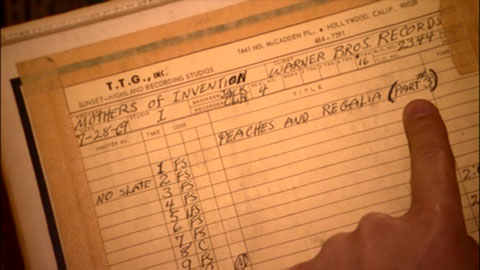
T.T.G., INC.
SUNSET-HIGHLAND RECORDING STUDIOS
MOTHERS OF INVENTION
WARNER BROS RECORDS
7-28-69
Engineer: Jack [Hunt]
Recorder: Cliff [Goldstein]
PEACHES AND REGALIA (PART 3)
If the melody was capable of standing by itself, why not just release it as an instrumental? You did that with other pieces such as "Peaches en Regalia."
"Peaches en Regalia" is the only one I've never really been able to write words for. I've tried, but I can't come up with a set of lyrics which will work with it. The trouble when it comes to writing lyrics depends on where you're sitting and the size of your challenge; whether you're going for intelligibility or going for a phonic sense that matches the line. The only way I can judge my words is by whether I achieve what I set out to do with the thing. I thought I had really done myself an anagram by the time I got done putting words to that instrumental tune. If you saw that tune on a piece of paper and somebody handed it to you in a music class and said "write lyrics to this" you'd be hard-pressed to do it. One syllable per eighth note. You can't change the melody. That's the game.
Sources & Edits
2. Willie The Pimp
Sources & Edits
| 2. "Willie The Pimp" Hot Rats (1969; Zappa Records, 2012) |
2. "Willie The Pimp" Hot Rats (CD, 1987) / 5.02. "Willie The Pimp" The Hot Rats Sessions (2019) |
2.09. "Willie The Pimp (Unedited Master Take)" The Hot Rats Sessions (2019) |
2.10. "Willie The Pimp (Guitar OD 1)" The Hot Rats Sessions (2019) |
2.11. "Willie The Pimp (Guitar OD 2)" The Hot Rats Sessions (2019) |
6.06. "Willie The Pimp (Vocal Tracks)" The Hot Rats Sessions (2019) |
6.07. "Willie The Pimp (1969 Quick Mix)" The Hot Rats Sessions (2019) |
| |
|
00:00-00:17 |
|
|
|
|
| |
0:00-0:09 |
00:17-00:27 |
|
|
|
|
| |
|
00:27-00:28 |
|
|
|
|
| 0:00-0:10 |
|
00:28-00:38 |
00:00-00:10 |
|
|
00:00-00:10 |
| 0:10-0:12 |
0:09-0:11 |
00:38-00:40 |
00:10-00:12 |
|
|
00:10-00:12 |
| 0:12-0:23 |
0:11-0:23 |
00:40-00:52 |
00:12-00:23 |
|
0:00-0:11 |
00:12-00:23 |
| |
0:23-0:26 |
00:52-00:54 |
00:23-00:26 |
|
0:11-0:14 |
00:23-00:26 |
| 0:23-2:11 |
0:26-2:13 |
00:54-02:42 |
00:26-02:13 |
|
0:14-2:01 |
00:26-02:13 |
| |
|
02:42-02:47 |
02:13-02:18 |
|
2:01-2:06 |
02:13-02:18 |
| |
|
02:47-03:47 |
02:18-03:18 |
0:00-1:00 |
|
02:18-03:18 |
| 2:11-5:03 |
2:13-5:05 |
03:47-06:39 |
03:18-06:10 |
1:00-3:52 |
|
03:18-06:09 |
| |
|
06:39-07:20 |
06:10-06:51 |
3:52-4:32 |
|
06:09-06:50 |
| |
|
07:20-07:22 |
06:51-06:53 |
4:32-4:35 |
|
|
| 5:03-5:06 |
5:05-5:08 |
07:22-07:25 |
06:53-06:56 |
4:35-4:38 |
|
|
| 5:06-5:11 |
5:08-5:13 |
07:25-07:30 |
06:56-07:01 |
4:38-4:43 |
|
06:50-06:55 |
| 5:11-5:14 |
5:13-5:16 |
07:30-07:33 |
07:01-07:04 |
4:43-4:46 |
|
|
| 5:14-5:25 |
5:16-5:27 |
07:33-07:44 |
07:04-07:15 |
4:46-4:57 |
|
06:55-07:06 |
| |
|
07:44-07:54 |
07:15-07:25 |
4:57-5:07 |
|
07:06-07:16 |
| 5:25-5:57 |
5:27-5:59 |
07:54-08:26 |
07:25-07:58 |
5:07-5:39 |
|
07:16-07:48 |
| 5:57-6:23 |
|
08:26-08:53 |
07:58-08:24 |
5:59-6:06 |
|
07:48-08:15 |
| |
|
08:53-09:03 |
08:24-08:34 |
6:06-6:16 |
|
08:15-08:25 |
| 6:23-7:30 |
5:59-7:05 |
09:03-10:09 |
08:34-09:40 |
|
|
08:25-09:31 |
| |
7:05-7:21 |
10:09-10:25 |
09:40-09:56 |
|
|
09:31-09:46 |
| 7:30-7:45 |
7:21-7:36 |
10:25-10:40 |
09:56-10:11 |
|
|
09:46-10:01 |
| |
|
10:40-11:25 |
10:11-10:57 |
|
|
10:01-10:47 |
| 7:45-8:00 |
7:36-7:51 |
11:25-11:40 |
10:57-11:12 |
|
|
10:47-11:02 |
| |
|
11:40-11:51 |
11:12-11:22 |
|
|
11:02-11:12 |
| 8:00-8:56 |
7:51-8:48 |
11:51-12:47 |
11:22-12:18 |
|
|
11:12-12:08 |
| |
|
12:47-14:42 |
12:18-14:14 |
|
|
12:08-14:03 |
| 8:56-8:59 |
|
14:42-14:45 |
14:14-14:16 |
|
|
14:03-14:06 |
| 8:59-9:23 |
8:48-9:11 |
14:45-15:09 |
14:16-14:40 |
|
|
14:06-14:29 |
| |
9:11-9:16 |
15:09-15:13 |
14:40-14:45 |
|
|
|
Barry Miles, Mojo, 1993
It was 2am, September 1969, and I was having a cup of styrofoam coffee with Don Van Vliet in the 24-hour automated snack-bar of TT&G studios in Los Angeles while he waited to add vocals to a Frank Zappa track.
His face was green in the fluorescent lighting, a nightclub pallor. Coming from the desert, Don never went out in the sun, rarely went out in the daytime at all. He said he would like to live in England because he understood there was no sun there. The edges of the formica-topped tables were serrated with cigarette burns and the room was overlit and bleak.
We looked out of the window. Outside, the magical skyline of palms and twinkling lights was dominated by 'the biggest psychedelic mural in the world' on the side of the theatre playing Hair.
Don told me, conversationally, that he could break glass with his voice:
'I once blew out a $1,200 Telefunken microphone.' I was impressed. He took a deep breath and emitted a long-drawn-out yell. We inspected the window. Not a crack. 'I'm feeling a little tired,' he said.
Just then the door was thrown open and a furious Frank Zappa burst in:
'What the fuck was that?' he demanded. The yell had penetrated the studio sound proofing and leaked onto a track. He was recording Hot Rats, though Don's vocal on Willie The Pimp was not recorded until the next night.
For most of the session Don sat in the corner of the control booth, absolutely still (maybe even asleep) as Frank overdubbed a new ending onto one of his guitar solos. When Gail Zappa showed up before dawn, Don had gone.
Driving home up Laurel Canyon, Gail steering the Buick with the palm of her hand, Frank seemed visibly distressed. 'He's burned them all,' Frank told her. 'You didn't have photocopies?' Gail asked. 'No. Years of work. He told me tonight. He did it two weeks ago.'
Don had destroyed the only copies of hundreds of his songs. Zappa's dismay showed the depth of his respect for his friend's work, despite the fact that they were not on the best of terms.
Barry Miles, ZigZag #6, October 1969
Gail Zappa picked up Frank (her husband) and me at TT&G Studios at Sunset and Highland . . . . Gail said, "Don freaked out today and burned all his manuscripts and books. He was over at the house earlier and seemed very depressed about not having a band and everything." All Frank could reply was "Oh brother!" Later it was found that copies had been made, so the 40 books of poems and songs and drawings were still in existence, only the originals were gone.
Captain Beefheart, Oui Magazine, July 1973
Oui: If you had this tremendous battle with Zappa, why did you record Willie the Pimp on his album?
Beefheart: I just thought to myself, "All right, man, you had your hand in my album and messed it up. I'm gonna come over and do a song for you as good as I can do it, and maybe that'll show you the difference." I wanted especially to show him that bygones could be bygones. I couldn't believe that he could do what he did. Frank Zappa sent me in the night to Warner Bros., and I didn't even know it. I'm talking about the way the Indians were sold on the reservation. I suppose that's what you get for dealing with old fools you meet in the desert.
"Willie the Pimp" (from Hot Rats, 1970)—Les Paul guitar ("since stolen from me"), Fender Deluxe amp, wah-wah pedal.
"I was overdubbing the solo while standing in the control room. The guitar was going into the board, out of the board, into the studio, into the amp, picked up by a microphone and back into the board.
"I'm playing my wah-wah pedal and wailing away, and this guy from the union comes in. He's standing behind me, tapping his pencil on his clipboard, waiting for me to get done so that he can ask me whether or not I've filed some kind of union paper about how many musicians I'm using. That's the solo on the record, and the whole time there was this union pood-head standing behind me."
The Lyrics
HOT SOOTS
Additional informant: Veniero Rizzardi.













